Cranberry Poundcake Bread Pudding
- At November 18, 2017
- By megan
- In cake, cranberries, dessert, favorites, Recipes, Sean Smith, strawberries, thanksgiving
 0
0
One of my favorite desserts that Sean makes is pound cake. It’s a simple cake that tastes just like childhood to me as I ate Entenmann’s pound cake by the pound whenever my parents bought it. This twist on bread pudding using home made pound cake as the “bread,” though really labor intensive, is a winner. Especially for holiday parties.
There are three main steps:
1- make a pound cake
2- make a cranberry compote
3- make the poundcake bread pudding
I’ll walk you through these three steps.
Pound Cake
Ingredients-
- 1 cup unsalted butter
- 1 cup sugar
- 2 tsp vanilla extract
- 2 cups all purpose flour
- 4 large eggs
- 1/2 tsp salt
Directions-
Preheat oven to 350 degrees. Butter and flour a six cup loaf pan.
In a KitchenAid stand mixer, cream the butter and sugar together on a high speed. Add eggs one at a time, vanilla, and salt and mix until well combined. Turn the mixer to low and slowly add the flour until it’s all combined.
Pour the batter into the loaf pan and bake for an hour or so until a toothpick inserted in the center comes out clean. Let it cool in the pan for 15 minutes before removing it from the pan to cool on a wire rack.
Cranberry Compote
The next step is to make a cranberry compote. Sean added a couple bags of frozen cranberries to a pan on medium heat like you’d start to make a cranberry sauce. He then added a little water, approximately 1/2 cup of sugar, a handful of frozen strawberries, a handful of frozen blueberries, and some frozen raspberries. This will turn into a sauce if you let it simmer for 30-40 minutes. He added some orange zest at the end.
This part of the recipe can be adjusted to your likes. The addition of sweeter berries allows for a little less sugar and still makes the cranberry sauce really sweet.
The final step is to assemble the bread pudding.
Cut the poundcake up into cubes and let it sit out at room temperature over night to get a little dry.
Cranberry Poundcake Bread Pudding
Ingredients:
- 1 loaf poundcake cut into cubes
- 2 TB melted butter
- 4 eggs
- 2 cups milk
- 1/2 cup sugar
- 1 tsp ground cinnamon
- tsp vanilla extract
- 1.5 cups cranberry compote
Preheat oven to 350.
Put the pound cake cubes in a square pyrex baking dish and drizzle melted butter over the top.
In your KitchenAid stand mixer, combine the eggs, milk, sugar, cinnamon, vanilla, and cranberry compote and mix until well combined. Pour over the pound cake and lightly push down on it with a fork to be sure the bread is covered and soaking it all up. Let this sit on the counter for 45 minutes or so to be sure it has soaked up the mixture before baking for 45 minutes and has cooked through.
Chef Sean served food to Opera on Tap Colorado at Upslope Brewing Company, and he served this dessert paired with their Christmas Ale. Smear a little extra compote on the plate and a dollop on top and shove a fork in it!
Enjoy!
Chipotle Roasted Fall Vegetables
So summer is over, but that doesn’t mean that there still isn’t amazing local produce to cook up. A few things I love doing this time of year, especially when the temperature drops down, is roasting what I can still get from the farmers market. One of my favorites is combining root vegetables with the slightly spicy chipotle pepper. There is something about the earthiness of root vegetables and the smoked flavor that chipotles bring that are a match made in heaven. Turnips and rutabagas work best for this but a few other choice fall veggies help to round out the side dish. This dish compliments most proteins, especially turkey which of course is going to be on everyone’s plate in a few weeks!
ROASTED FALL VEGTABLES WITH CHIPOTLE
1 Medium Turnip
1 Medium Rutabaga
1 Large Parsnip
2 Large Carrots
1 Large Yellow Onion
1 Can of Chipotle in Adobo Sauce
Set oven to 375. Peel and dice the root vegetables. I like to leave them a little chunky but as long as they’re uniformly cut they should roast up just fine. Next, toss the vegetables in a high heat cooking oil. You want enough oil to coat them but not to much where they get soggy. Then, and this is where the recipe can be changed depending on your affinity for spicy foods, toss the vegetables with at least 2 chipotle peppers and about a tablespoon of the adobo sauce. Don’t worry if you think you’ve added to much, once the natural starches in the veggies convert to sugars while roasting in the oven it will taste delicious. And if you like things with some heat, add in a couple more peppers and sauce. Give a quick toss with some salt and spread out on a baking sheet. Bake until fork tender, about 30 minutes, mixing occasionally.

I also roasted a Kabocha Squash seasoned with Black Dust Coffee & Spice Rub from Savory Spice Shop.
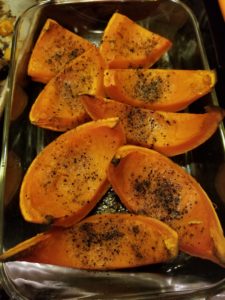
These two together make for a unique Thanksgiving side dish.
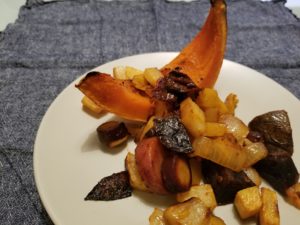
Sweet Potato & Chevre Gratin
Cool weather is here and what better way to help heat the house than to bake something! Colder temperatures also mean that the flavor of certain vegetables, such as sweet potatoes and yams. The plant, when faced with dropping temperatures, starts to convert the natural starches into sugars so it can survive. What does that mean? It means fall time is the best time to eat these tubers.
This side dish is perfect for any occasion, especially right around Thanksgiving. Now, sweet potatoes and yams are interchangeable but they do have some differences. Most yams will have a little more water content than their close cousins. Yams are better to mash up but will work in a this sort of application. But “Jeweled” or “”Garnet” sweet potatoes are what are most common, although I’m sure your local farmer could help you decide.
SWEET POTATO & CHEVRE GRATIN
4 Large Sweet Potatoes
1 Pint Heavy Whipping Cream
7 Ounces Goat Cheese
Heat oven to 375. Peel and slice the sweet potatoes using a mandolin, making sure that cuts are uniform. I find it easier to make “coins” rather than trying to cut the veggies lengthwise. Using a 7″ by 10″ baking dish, layer sweet potatoes with cream and crumbled goat cheese. I like to season every other layer with salt and pepper so that the dish is flavorful but not over seasoned. Potatoes should be covered in cream but not swimming, they have water that will cook out during baking.
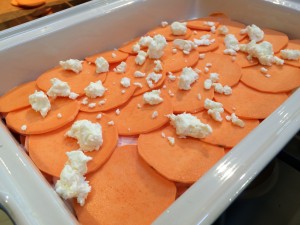
Bake uncovered until gratin is easily pierced with a knife, about 45 minutes.

How To Make Garlicky Dill Pickles
For some reason people think making pickles is difficult. But, making pickles isn’t hard, especially once you get the hang of it. My twin sister thinks I’m some sort genius at this kind of culinary art and should write a book about said practice. Once you understand the nuances in flavor that help create the brine, it really isn’t rocket science. Hell, if I can do it, pretty much anyone with half a brain can. There is some trial and error, so if you’re just starting out be prepared to throw some food away. Even I still stumble. I recently cracked a jar of pickled rhubarb from last year, since rhubarb is now in season, and was planning on replacing last year’s canned bounty with this year’s offering. The first bite was immediately spit into the kitchen sink. Who the F made this garbage!?! Oh right, yours truly. Not that the flavor was off or had spoiled (thankfully) but the acid in the brine had turned the rhubarb to complete mush over time. Lesson learned. So you’re going to win some and you’re going to loose some but over time you’ll be knocking it out of the park like you’re a freaking starter for the best baseball team in the league (aka The RED SOX, duh!).
But before we get into the actual recipe and it’s steps, let’s give a quick synopsis of what it means to be a “pickle.” Most Americans seem to think a pickle is just a fancy, spiced-up cucumber, looking down it’s nose at it’s boring cousin. Sure that’s true, but what is being pickled doesn’t have to be a cucumber. As I stated earlier, I’ve pickled rhubarb. I also have a jar of pickled cherries I’m waiting to open and recently posted a pickled garlic scape recipe. I haven’t done it yet, but you can even pickle eggs. The closest I’ve ever come to that is a pickled egg juice-back after a whiskey shot, and don’t even get me started on what a sh*t show of a night out in NYC that was! So, as Portlandia famously stated and is oft quoted around our house, “You can pickle that!”
That said, there are different forms of pickling and certain kinds work better for whatever is being preserved. The easiest method, which I’ll be showcasing, is “quick pickles” aka “refrigerator pickles.” Moving on from there, “freezer pickles” are usually fruit based since the sugar content helps seal in flavor. Indian cuisine also has many pickles but we Americans living in a very sheltered food world, call all them “chutneys.” Asian food also has many types of pickles. I mean, Korea practically runs on Kim Chi.
Which leads me to the most complex way to pickle something, “fermentation.” I won’t get into the complicated process here and will save it for another time but yes, you probably have at some point eaten a fermented cucumber labeled as a “pickle.” Ever had a “full sour” or “half sour” pickle? Yeah those tasty little things sat out at room temperature long enough for cultures to form and give tartness to the cucumber. Hot Doug’s (RIP) in Chicago had a killer version of the full sour and in my experiments, that meant the batch sat out for about two weeks. I dare you to leave something on the counter for that long, consume it and be whisked off to tastebud Nirvana. (No, PLEASE don’t do that!) More likely than not you’ll be spewing your guts out. But hey “A” for effort! I digress. Let’s get this pickle party pumping…
GARLICKY DILL PICKLES
1# Pickling Cucumbers
5 Sprigs Fresh Dill
3 Garlic Cloves
4 Chiles De Arbol
1/2 t Whole Peppercorns
1/2 t Whole Coriander Seeds
1 1/2 t Salt
1 t Sugar
1 C Water
1 1/2 C Distilled Vinegar
Pickling cucumbers come in all shapes and sizes. Some farmers will actually sell their ugly looking regular cucumbers as pickling ones. They work but have a higher water content and less sturdy flesh so they’re not ideal for this process. What you’re looking for are the stubby, bumpy, is-that-safe-to-put-in-my-mouth kind of cucumber. You may have to trim your cucumber down into spears (or into rounds if you prefer) but I selected little whole ones. I love shoving whole pickles in my mouth, take that as you will. So give your cukes a rinse before cutting it if doing so, as well as the dill. Let them dry and place them in a quart jar, alternating between pickles and dill. Why do you think we do that? To help spread the flavor of dill around.
Next up you’re going to take your garlic cloves and gently crush them. You can smash them if you had a bad day at the office but I’d recommend taking the flat edge of a chefs knife, blade away from you (come on, safety first!) on top of a clove and apply pressure until you feel the clove crack. Feel free to increase the amount of garlic if you really dig on that sort of thing, and the same goes for the chile de arbol if you like pickles with a little more heat. Take all of the ingredients and put them in a pot, give it a quick stir, and crank it up to high on the stove. Heat the mixture until the salt and sugar has dissolved. If you’re unsure if they have, just bring it to a boil.
Now this is important <read- don’t screw it up>
Remove the mixture from heat and allow it to COOL to room temperature. Despite all of their tough looking exterior, cucumbers are delicate. If you pour hot liquid over them, they just go soft. Also, before pouring the brine over the stuff in the jar, give it one last stir to mix up all the aromatics. Pour the brine to cover the cucumbers and turn the jar over a couple of times to mix up everything. Don’t shake it. Remember what I said about delicate! Place it in the fridge and let it sit for at least 48 hours. If you have ants in your pants, 24 hours will work, but you are missing out on some serious flavor country. The longer they sit the better they get and could even last over a year. But if those delicious little cukes are still there that long, you should probably just stick to eating fast food.
Last but not least, there are a million and one pickling books out there (another reason I won’t be writing one anytime soon, sorry sis) but I really love “The Joy of Pickling” by Linda Ziedrich. It has very user friendly recipes which taste great. The book features easy pickling recipes as well as more complex ways of preserving food. But wait there’s more! (I swear I’m not getting paid for this.) The Joy of Pickling has a global perspective and features recipes from around the world, as well as short pieces on each area’s use of pickles and their ingredients.
As always feel free to contact me for questions or recipes, I do have larger industrial-sized pickling recipes if you want to go crazy!
Cheers,
Chef Sean

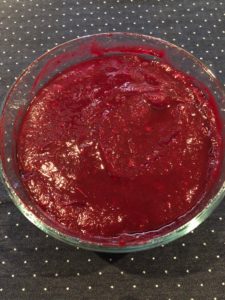
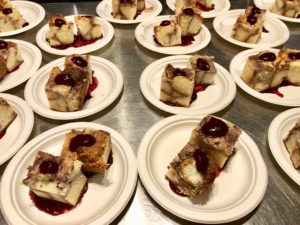
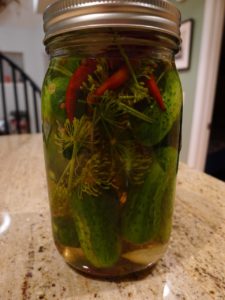


Let’s get Social